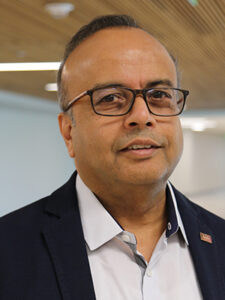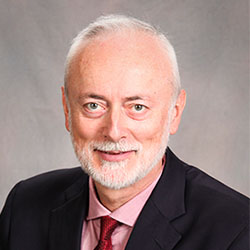Course Director: Dr. Robert Balog
Next Offering: Spring 2025
Description
This course covers the basics of grid-connected photovoltaic (PV) systems. Starting with the solar resource, we will learn about how photovoltaic energy conversion is used to produce electric power. The course will highlight the photoelectric effect, how we model the electrical characteristics of PV cells, environmental conditions that effect the operation and performance of the PV cells, different types of solar cell. Then we will explore how these effects come together as cells are combined into modules, modules into strings, and strings into arrays. The role of power electronics will be explored including maximum power point tracking, power optimizers, and inverters including central plant inverters, string inverters, and microinverters. As PV penetration in the grid increases, new challenges and opportunities in generation aggregation and virtula power plant will be examined. Lastly, we will explore the history of the codes and standards of the industry with attention to more recent changes and emerging changes being proposed.
Collectively the course instructors have extensive experience in this area as technology researchers, developers, and educators. (Hours: CEU 2.1, PDH 21).
Who Should Attend
This course is ideally suited for those who work in areas associated with the electric grid and need to gain an understanding of grid-connected photovoltaic energy systems. The course is also appropriate for non-technical professionals at electric utilities and other companies in the electric power industry as well as for staff at regulatory agencies, government officials, developers, investment bankers, etc. This short course is particularly useful for those who manage electric power engineers, for new engineers from other disciplines, for academics wishing to gain practical knowledge in this important area, and for graduate students interested in careers in the power industry.
This course counts toward the Texas A&M Certificate in Electrical Power Engineering.
Topics
- The solar resource: the sun and the earth.
- The photovoltaic (PV) effect: converting sunlight to electricity.
- Electrical characteristics of PV.
- Maximum power point tracking.
- Power electronics for DC-DC converters and DC-AC inverters.
- Grid interconnection issues including synchronization, anti-islanding, and others.
- Grid-forming and Grid-Following Inverters.
- PV aggregation and virtual power plant
- Codes and Standards: a historical view and present-day requirements.
- Experiential learning: there will be opportunities for “hands-on” mini-labs to use measurement equipment, collect, and analysis performance data from a real outdoor solar array.
Logistics
Dates and Times: Spring 2025
Location: Texas A&M Center for Infrastructure Renewal (CIR), 1041 RELLIS Parkway, Bryan TX
Air Transportation:
Direct flights available at the Texas A&M Easterwood Airport (CLL) from Dallas-Fort Worth (DFW) on American and Houston (IAH) on United.
Other airports within driving distance: Austin (AUS) and Houston (IAH), both about two hours away
May rent car or use shuttle service: Airport Ground Shuttle
Registration Cost: $1,795. Discount of 25% is available for employees of Smart Grid Center member companies. For more information on the discount, contact SGC@tamu.edu.
Instructors

Robert Balog, Ph.D. is a Professor in the Department of Electrical and Computer Engineering at Texas A&M University (TAMU), Director of the Renewable Energy and Advanced Power Electronics Research laboratory (www.REAPERlab.com), and Assistant Director for Grid Edge Modernization of TEES Smart Grid Center (smartgridcenter.tamu.edu). He received his BS degree in Electrical Engineering from the Rutgers in 1996, The State University Of New Jersey and his MS, and Ph.D. degrees in Electrical Engineering from the University of Illinois at Urbana-Champaign in 2002 and 2006 respectively. From 1996 to 1999, he was an Engineer with Lutron Electronics, Coopersburg, PA, USA. From 2005 to 2006, he was a Researcher Consultant with the U.S. Army Corp of Engineers, Engineering Research and Development Center, Construction Engineering Research Laboratory, Champaign, IL, USA where he was involved in researching concepts for military microgrids. From 2006 to 2009, he was a Senior Engineer at SolarBridge Technologies, Champaign, IL, USA where he co-invented the original technologies, directed the initial engineering team, and was part of the executive team that secured initial venture capital funding. His current research interests include power electronic converters and balance-of-systems technologies for solar photovoltaic energy, microinverters for ac photovoltaic modules, arc fault detection for dc and photovoltaic systems, highly reliable electrical power and energy systems including dc microgrids, and power electronics at the grid edge including reactive power and harmonic power compensation in distribution systems. Dr. Balog is a Registered Professional Engineer in the states of Illinois and Texas. He received the IEEE Joseph J. Suozzi INTELEC Fellowship in Power Electronics in 2001 and had served multiple appointments as a Distinguished Lecturer for the Power Electronics Society. He is the holder of 21 issued U.S. patents with additional patents pending. He was the recipient of the 2011 Rutgers College of Engineering Distinguished Engineer Award. He is a senior member of the IEEE and the National Academy of Inventors. He is a voting member of UL 1741 and UL 1699B Standards Technical Panel.
Miroslav M. Begovic, Ph.D. is the Moore Professor and associate Director of the Smart Grid Center, and former Department Head of Electrical and Computer Engineering at Texas A&M University. Prior to that, he was Professor and Chair of the Electric Energy Research Group in the School of Electrical and Computer Engineering, and an affiliated faculty member of the Brook Byers Institute for Sustainable Systems and University Center of Excellence in Photovoltaic Research at Georgia Tech. Dr. Begovic obtained his PhD from Virginia Tech University. His research interests are in monitoring, analysis, and control of power systems, as well as development and applications of renewable and sustainable energy systems. For the Centennial Olympic Games in 1996 in Atlanta, he designed with Professor Ajeet Rohatgi a 340 kW photovoltaic system on the roof of Aquatic Center at Georgia Tech, which at that time was the largest roof-mounted PV system in the world. He has been a member of the IEEE PES Power System Relaying Committee for two decades and chaired a number of its working groups. Dr. Begovic is a Life Fellow of IEEE and member of Sigma Xi, Tau Beta Pi, Phi Kappa Phi and Eta Kappa Nu. Dr. Begovic is a former President of the IEEE Power and Energy Society and Chair of IEEE PES Governing Board, and recipient of IEEE PES Meritorious Service Award (2019), as well as IEEE PES Ramakumar Family Award for Excellence in Renewable Energy (2022).

Prasad Enjeti, Ph.D. is the Jack Kilby Chair Professor in Electrical and Computer Engineering Department at TAMU and he has been a member of Texas A&M University Faculty, since 1988. He is widely acknowledged to be a distinguished teacher, a scholar, and a researcher. To date, he has graduated 35 Ph.D. and 53 M.S. students. 15 of his Ph.D. students currently serve as a faculty in institutions at home and across the world while others have leadership positions in industry. He along with his students has more than 100 journal publications and received numerous best paper awards from the IEEE. His primary research interest includes advancing power electronic converter designs to address complex power management issues. His current research focus has been on innovative power electronic solutions to interface renewable energy sources to electric utility and developing real time digital tools to enhance cybersecurity and condition monitoring of industrial systems. Dr. Enjeti was a recipient of the IEEE Fellow Award, in 2000, the Texas A&M University Association of Former Students University Level Teaching Award, in 2001, the R. David Middlebrook Technical Achievement Award from the IEEE Power Electronics Society, in 2012, and the IEEE IAS Distinguished Achievement Award, in 2021, among the many honors.

Dan Lepinski, P.E. is a true pioneer in the solar energy field. He is a Licensed Professional Engineer who has been involved in solar energy for more than 50 years as a design engineer of solar energy systems as well as equipment. He is named on patents as an inventor of inverters in use today in the solar industry. Dan served as a voting member of the UL 1741 Standards Technical Panel, a group of experts highly vetted by UL for the purpose of authoring the UL 1741 Safety Standard for the solar energy industry. He’s an active member of the Solar America Board for Codes and Standards, the Electric Power Research Institute (EPRI) “Smart Grid” Development Committee, IEEE 1547 Development Committee, and participated on the Solar Energy Industry Task Force that interacts with the National Fire Protection Association for the National Electric Code, NFPA 70. In 2010, Dan was honored by the State of Texas Renewable Energy Industries Association with a Special Achievement Award for Excellence and Accomplishments in the field of Solar Energy. In 2016, he was selected by the State of Texas as the State’s most qualified Subject Matter Expert in solar energy, where he was tasked with conducting 20 educational workshops statewide in solar energy for State of Texas Policy-makers, Code Officials, and others. Known nationally and internationally throughout the solar energy industry, Dan has a unique talent for discussing even the most complex aspects of solar energy in plain English — understandable by all.
For More Information
- For more information about this course, contact Dr. Robert Balog at rbalog@tamu.edu,
- For other upcoming Texas A&M electric power short courses, contact Dr. Tom Overbye at overbye@tamu.edu or visit his research website at overbye.engr.tamu.edu.

